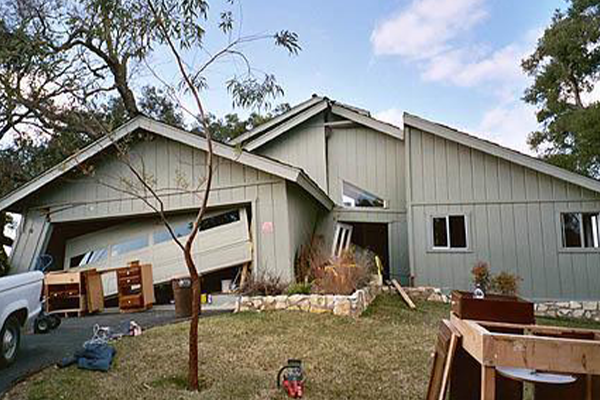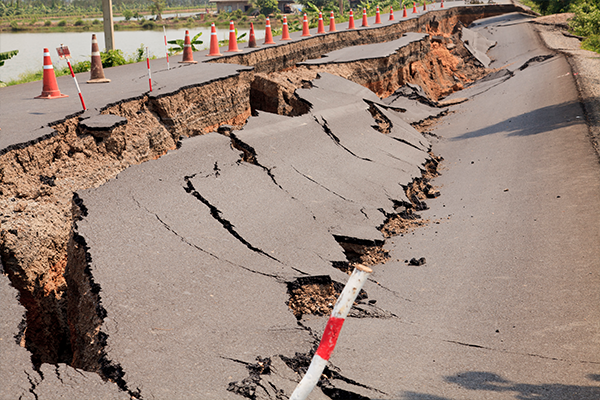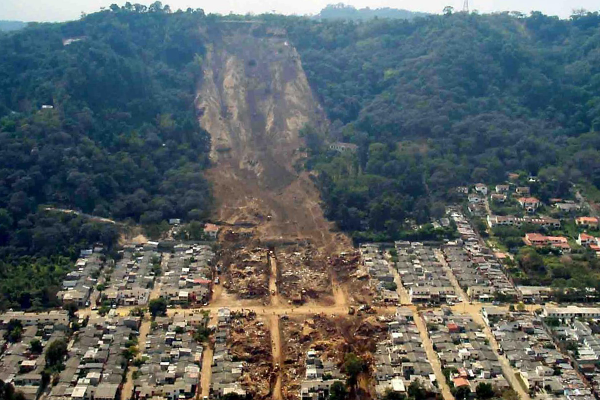The destructive effects of earthquakes are from landslides, tsunamis, fires, and fault rupture. The violent shaking of the ground produces the greatest property losses and personal injuries.
In California, the collapse of buildings, roads and infrastructure produced eight of the ten costliest earthquakes in the last one hundred years. The U.S. Geological Survey reports there is a 72 percent probability that an earthquake of magnitude 6.7 or larger will strike the San Francisco Bay area within the next 30 years. Southern California has a 60% chance of experiences an earthquake measuring magnitude 6.7 in the same timeframe.
Why are earthquakes dangerous?
The damage caused by earthquakes is from ground shaking, ground rupture, landslides, tsunamis, and liquefaction. Earthquake damage from fires is the most important secondary effect.
The Ridgecrest earthquakes that hit on July 4 and July 5, 2019 with a magnitude 6.4 and 7.1, respectively, were the most recent major earthquakes in Southern California. The second quake with a magnitude 7.1 lasted 12 seconds and was felt by about 30 million people from Sacramento to San Diego. More than 6,000 homes lost power.
The Ridgecrest earthquakes followed a 25-year "quiet period" after the Northridge earthquake. Northridge, at a 6.7 magnitude earthquake, killed 58 people, injured more than 9,000 and caused more than $49 billion in economic loss.
How do Earthquakes Cause Damage
Earthquake destruction begins with the earth’s violent shaking that can rupture the earth, trigger landslides and turn the surface of the earth to liquid. The damaging shaking of major earthquakes can be felt hundreds of miles away.
Ground Shaking & Structural Failure
Ground shaking is the vibration of the ground during an earthquake. The shaking triggers other hazards such as liquefaction and landslides. Most earthquake damage results from the seismic waves passing beneath buildings, roads, and other structures.
Surface Rupture & Ground Displacement
The primary earthquake hazard is surface rupture. It can be caused by vertical or horizontal movement on either side of a ruptured fault. Ground displacement, which can affect large land areas, can produce severe damage to structures, roads, railways and pipelines.
Landslides
Earthquakes can trigger landslides and mudslides, especially in areas with water-soaked soils. Landslides may result in falling rocks and debris that collide with people, trees, animals, buildings and vehicles. They also can block roads and disrupt utility lines.
Liquefaction
The shaking from an earthquake can turn loose soil into a liquid during an earthquake.
Liquefaction can undermine the foundations and supports of buildings, bridges, pipelines, and roads, causing them to sink into the ground, collapse or dissolve.
Tsunamis
An earthquake generated within the Pacific Ocean floor will generate a tsunami, which is actually a series of very long waves. Large tsunamis which travel to the ocean floor to the surface are dangerous to human health, property, and infrastructure. Long lasting effects of tsunami destruction can be felt beyond the coastline.
Fires
Earthquake damage facts show fires caused by earthquakes are the second most common hazard. Earthquake fires start when electrical and gas lines are dislodged due to the earth’s shaking. Gas is set free as gas lines are broken and a spark will start a firestorm.
Destruction Caused by Earthquakes
Every region of the Golden State holds earthquake risk. Most of us live within 30 miles of an active fault. How dangerous are earthquakes? Earthquakes can shake houses off their foundations, turn soil to liquid, and cause landslides.
Earth Shaking
This GIF shows an illustrated example of how an earthquake’s sudden release of pressure and seismic waves can cause earth shaking and ground displacement, showing up in this example as cracks in the ground soil. Liquefaction can also occur and turn the soil to liquid. Ground shaking often leads to other hazards and types of damage, such as a house shifting off its foundation.
Surface Rupture
The vibrations from an earthquake can lead to ground displacement and surface rupture. The surface rupture can cause other hazards, as well as damage to roads and buildings. In this example, the surface rupture has caused large cracks and the collapse of a paved road. This could lead to injuries, loss of life, or impede people from getting home or to work.
Landslides
Earthquakes often trigger landslides, which can cause catastrophic damage to homes and towns. This image of a landslide in El Salvador in 2001 shows how destructive landslides can be to people and their homes.
How to mitigate earthquake damage
The shaking from a major earthquake can shake and shift almost everything inside your home. According to a UCLA study, the majority of the injuries from the damaging 1994 Northridge earthquake were from heavy furniture and household objects falling on people.
To prepare for next earthquake, evaluate the safety of your home. Your home safety review ranks high on your earthquake preparation checklist, after preparing your earthquake safety kit and gathering essential supplies. Keep your family safe and prevent the injury of your loved ones by being prepared.
Personal Preparedness Guidelines
Earthquakes produce sudden, rapid shaking of the earth caused by the shifting of rock beneath the earth’s surface. Earthquakes strike without warning, at any time of year, day or night. Avoid earthquake damage and injury.
Prepare now for your family’s safety and recovery from a devastating earthquake. Create an earthquake safety plan. Practice Drop, Cover, and Hold On.
The 2019 Ridgecrest earthquakes that hit Southern California were felt as far away as Las Vegas and Arizona. The 7.1 and 6.4 quakes were the largest to strike in twenty years.
Learn about earthquake survival tips to keep your family prepared before the next big one hits.
Understand Geologic & Structural Risks to Your House
Every Californian faces earthquake danger based on the location of their homes or work. California is earthquake country, with nearly 16,000 known faults and more than 500 active faults. Most of us live within 30 miles of an active fault risk.
Find out about faults in your area by visiting the CEA risk map for each county. This information will help you survive an earthquake.
Earthquakes cause landslides, mudslides, surface rupture and liquefaction of the soil. Learn about geologic hazards in your community and structural threats to your home.
Then learn about your home’s structural risks, the steps you can take to seismically strengthen your house and the benefits of retrofitting. Make your home more resistant to earthquake damage by assessing its structure and contents.
Is your house at risk of earthquake damage?
Avoid earthquake damage by learning about your home’s structural risks.
Earthquake safety preparation requires your understanding of the potential structural threats to your home in case of an earthquake.
Although there are a lot of different ways that earthquakes can cause damage, there are also many ways you can prepare. Learn how to prepare your house for earthquake risk to strengthen it and make it more resistant to earthquake damage—today!




